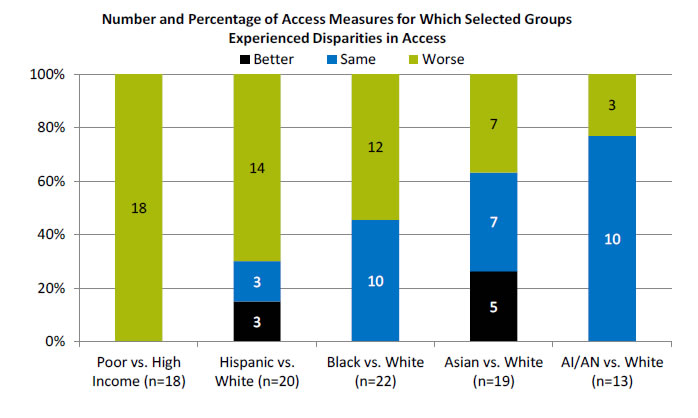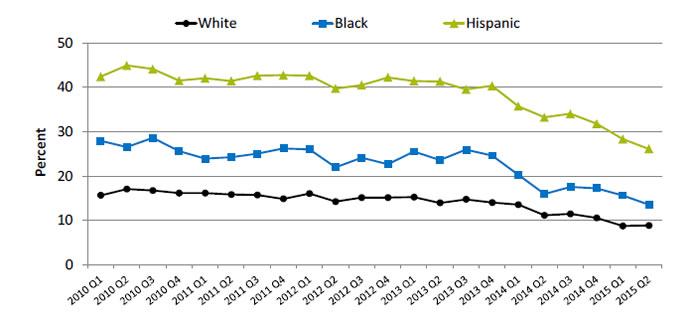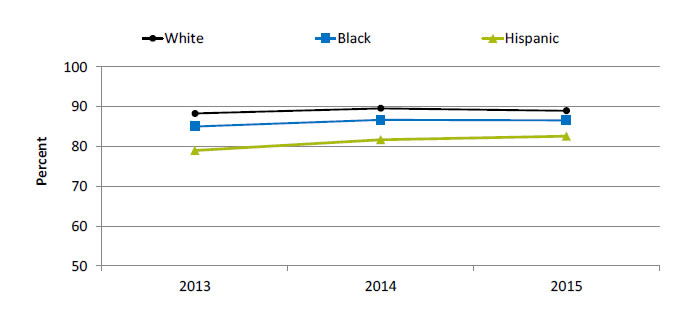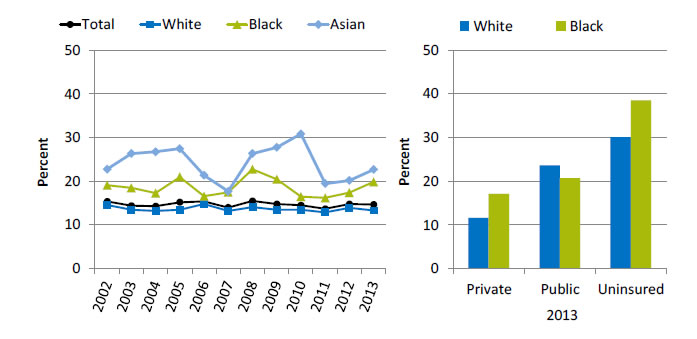QDR Chartbooks
- QDR supported by a series of related chartbooks that:
- Present information on individual measures.
- Are updated annually.
- Are posted on the Web (http://www.ahrq.gov/research/findings/nhqrdr/2014chartbooks/).
- Order and topics of chartbooks:
- Access to care.
- Priorities of the National Quality Strategy.
- Access and quality of care for priority populations.
- Information on individual measures is available through chartbooks posted on the Web (http://www.ahrq.gov/research/findings/nhqrdr/2014chartbooks/).
Six Chartbooks Organized Around Priorities of the National Quality Strategy
- Making care safer by reducing harm caused in the delivery of care.
- Ensuring that each person and family is engaged as partners in their care.
- Promoting effective communication and coordination of care.
- Promoting the most effective prevention and treatment practices for the leading causes of mortality, starting with cardiovascular disease.
- Working with communities to promote wide use of best practices to enable healthy living.
- Making quality care more affordable for individuals, families, employers, and governments by developing and spreading new health care delivery models.
Other Chartbooks Organized Around AHRQ's Priority Populations
- AHRQ's priority populations, specified in the Healthcare Research and Quality Act of 1999 (Public Law 106-129):
- Racial and ethnic minority groups.
- Low-income groups.
- Women.
- Children (under age 18).
- Older adults (age 65 and over).
- Residents of rural areas.
- Individuals with special health care needs, including:
- Individuals with disabilities.
- Individuals who need chronic care or end-of-life care.
Access to Health Care
Access Disparities
ACCESS DISPARITIES: In 2013, disparities were observed across a broad spectrum of access measures

| Poor vs. High Income (n=18) | Hispanic vs. White (n=20) | Black vs. White (n=22) | Asian vs. White (n=19) | AI/AN vs. White (n=13) | |
|---|---|---|---|---|---|
| Better | 3 | 5 | |||
| Same | 0 | 3 | 10 | 7 | 10 |
| Worse | 18 | 14 | 12 | 7 | 3 |
| Total | 18 | 20 | 22 | 19 | 13 |
Key: AI/AN = American Indian or Alaska Native; n = number of measures.
Note: Poor indicates family income less than the Federal poverty level; high income indicates family income four times the Federal poverty level or greater. Numbers of measures differ across groups because of sample size limitations. Measures that achieve an overall performance level of 95% or better are not reported in the QDR and are not included in these analyses. Because disparities are typically eliminated when overall performance reaches 95%, our analyses may overstate the percentage of measures exhibiting disparities.
The relative difference between a selected group and its reference group is used to assess disparities.
- Better = Population had better access to care than reference group. Differences are statistically significant, are equal to or larger than 10%, and favor the selected group.
- Same = Population and reference group had about the same access to care. Differences are not statistically significant or are smaller than 10%.
- Worse = Population had worse access to care than reference group. Differences are statistically significant, are equal to or larger than 10%, and favor the reference group.
Example: Compared with Whites, Blacks had worse access to care on 12 of the 22 access measures, similar access on 10 measures, and better access on no measures.
- Groups With Disparities:
- People in poor households experienced the largest number of disparities, followed by Hispanics and Blacks.
- In 2013, people in poor households had worse access to care than people in high-income households on all access measures (green).
- Blacks had worse access to care than Whites for about half of access measures.
- Hispanics had worse access to care than Whites for more than two-thirds of access measures.
- Asians and American Indians and Alaska Natives had worse access to care than Whites for about one-third of access measures.
Uninsurance
Adults ages 18-64 who were uninsured at the time of interview, by race/ethnicity, January 2010-June 2015

| Quarter | Hispanic | White | Black |
|---|---|---|---|
| 2010 Q1 | 42.4 | 15.6 | 27.9 |
| 2010 Q2 | 44.9 | 17 | 26.5 |
| 2010 Q3 | 44.1 | 16.7 | 28.6 |
| 2010 Q4 | 41.5 | 16.1 | 25.6 |
| 2011 Q1 | 42 | 16.1 | 23.9 |
| 2011 Q2 | 41.4 | 15.8 | 24.2 |
| 2011 Q3 | 42.6 | 15.7 | 25 |
| 2011 Q4 | 42.7 | 14.8 | 26.2 |
| 2012 Q1 | 42.6 | 16 | 26 |
| 2012 Q2 | 39.7 | 14.2 | 21.9 |
| 2012 Q3 | 40.5 | 15.1 | 24.1 |
| 2012 Q4 | 42.2 | 15.1 | 22.6 |
| 2013 Q1 | 41.4 | 15.2 | 25.5 |
| 2013 Q2 | 41.3 | 13.9 | 23.6 |
| 2013 Q3 | 39.5 | 14.7 | 25.9 |
| 2013 Q4 | 40.3 | 14 | 24.6 |
| 2014 Q1 | 35.7 | 13.5 | 20.2 |
| 2014 Q2 | 33.2 | 11.1 | 15.9 |
| 2014 Q3 | 34 | 11.4 | 17.5 |
| 2014 Q4 | 31.8 | 10.5 | 17.2 |
| 2015 Q1 | 28.3 | 8.7 | 15.6 |
| 2015 Q2 | 26.1 | 8.8 | 13.5 |
Key: Q = quarter.
Source: Centers for Disease Control and Prevention, National Center for Health Statistics, National Health Interview Survey, 2010 -2015, Family Core Component.
Note: For this measure, lower rates are better. Data only available for 2015 quarters 1 and 2.
- Trends: All racial/ethnic groups displayed a decrease from 2013 Q4 to 2015 Q2:
- White: 14.0% to 8.8%.
- Black: 24.6% to 13.5%.
- Hispanic: 40.3% to 26.1%.
- Groups With Disparities: Black adults ages 18-64 were significantly more likely than Whites to be uninsured from January 2010 to June 2015. The percentage peaked in the third quarter of 2010 at 28.6%, then significantly decreased to 13.5% for the second quarter of 2015.
Usual Source of Care
Age-sex adjusted percentage of people of all ages with a usual place to go for medical care, by race/ethnicity, 2013-2014 and January-September 2015

| Race/Ethnicity | 2013 | 2014 | 2015 |
|---|---|---|---|
| White | 88.3 | 89.6 | 89 |
| Black | 85 | 86.7 | 86.6 |
| Hispanic | 79 | 81.7 | 82.6 |
Source: Centers for Disease Control and Prevention, National Center for Health Statistics, National Health Interview Survey, 1997-2014 and January-June 2015, Combined Sample Adult and Sample Child Core Component.
Note: Data only available for 2015 quarters 1, 2, and 3.
- Groups With Disparities:
- From January to June 2015, after adjustment for age and sex, the percentage of people with a usual place to go for medical care was 82.6% for Hispanics, 89.0% for Whites, and 86.6% for Blacks.
- In all 3 years, Blacks were less likely to have a usual place to go for medical care compared with Whites.
Delays in Care
Adults who needed care right away for an illness, injury, or condition in the last 12 months who sometimes or never got care as soon as wanted, by race, 2002-2013, and stratified by insurance, Blacks and Whites, 2013

Left Chart:
| Race | 2002 | 2003 | 2004 | 2005 | 2006 | 2007 | 2008 | 2009 | 2010 | 2011 | 2012 | 2013 |
|---|---|---|---|---|---|---|---|---|---|---|---|---|
| Total | 15.3 | 14.3 | 14.2 | 15.1 | 15.3 | 13.9 | 15.4 | 14.7 | 14.4 | 13.6 | 14.7 | 14.6 |
| Black | 19 | 18.4 | 17.2 | 20.9 | 16.5 | 17.4 | 22.7 | 20.4 | 16.4 | 16.1 | 17.3 | 19.8 |
| White | 14.5 | 13.4 | 13.1 | 13.4 | 14.7 | 13.1 | 14 | 13.4 | 13.4 | 12.8 | 13.8 | 13.2 |
| Asian | 22.7 | 26.3 | 26.7 | 27.4 | 21.3 | 17.6 | 26.3 | 27.7 | 30.8 | 19.4 | 20.1 | 22.6 |
Right Chart:
| Insurance | White | Black |
|---|---|---|
| Private | 11.6 | 17.1 |
| Public | 23.6 | 20.7 |
| Uninsured | 30.1 | 38.5 |
Source: Agency for Healthcare Research and Quality, Center for Financing, Access, and Cost Trends, Medical Expenditure Panel Survey, 2002-2013.
- Trends: From 2002 to 2013, there were no statistically significant changes overall or for any racial group in the percentage of adults who needed care right away who sometimes or never got care as soon as wanted.
- Groups With Disparities:
- In 2013, the percentage of Blacks who needed care right away who sometimes or never got care as soon as wanted was significantly higher than the percentage of Whites who sometimes or never received care as soon as wanted.
- Among those with private insurance, the percentage who sometimes or never got care as soon as wanted was significantly higher for Blacks than for Whites.
HRSA-Supported Health Center Population
Characteristics of HRSA-supported health center population versus U.S. population, 2014

| Characteristics | Health Center Population | U.S. Population |
|---|---|---|
| White | 66.6 | 77.7 |
| Black | 23.4 | 13.2 |
| Asian | 3.8 | 5.4 |
| NHOPI | 1.2 | 0.2 |
| AI/AN | 1.3 | 1.2 |
| >1 Race | 3.7 | 2.5 |
| Non-Hispanic | 34.9 | 82.6 |
| Hispanic | 65.1 | 17.4 |
| Medicare | 8.6 | 15.6 |
| Medicaid | 47.3 | 19.5 |
| No Insurance | 27.9 | 10.4 |
| ≤100% FPL | 71.2 | 14.8 |
| ≤200% FPL | 92.4 | 33.4 |
Key: AI/AN = American Indian or Alaska Native; NHOPI = Native Hawaiian or Other Pacific Islander; FPL = Federal poverty level.
Source: Health Resources and Services Administration, Bureau of Primary Health Care, Uniform Data System, 2013. http://bphc.hrsa.gov/uds/datasnapshot.aspx?year=2013.
Note: Racial groups include non-Hispanic and Hispanic. Health center population only includes data from 1,202 program grantees.
- Groups With Disparities:
- In 2014, 71.2% of the health center population was at or below the Federal poverty level compared with 14.8% of the U.S. population. The health center population also had higher percentages of uninsurance (27.9%) and Medicaid enrollment (47.3%) than the U.S. population (10.4% and 19.5%, respectively).
- In 2014, the percentage of the health center population who was Black was nearly one-quarter (23.4%), nearly twice as much as the percentage in the U.S. population (13.2%). Slightly less than two-thirds (65.1%) of the health center population was Hispanic, which was much higher than the percentage in the U.S. population (17.4%).



